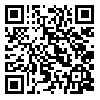Tue, Dec 30, 2025
Volume 10, Issue 3 (Summer 2024)
Caspian J Neurol Sci 2024, 10(3): 218-224 |
Back to browse issues page
Download citation:
BibTeX | RIS | EndNote | Medlars | ProCite | Reference Manager | RefWorks
Send citation to:



BibTeX | RIS | EndNote | Medlars | ProCite | Reference Manager | RefWorks
Send citation to:
Zarrabi H, Novin M H, Soleimani R, Shirkhan Maleki B, Speily S K. The Psychometric Properties of the Persian Version of the Smoking Urge Questionnaire in the General Population. Caspian J Neurol Sci 2024; 10 (3) :218-224
URL: http://cjns.gums.ac.ir/article-1-708-en.html
URL: http://cjns.gums.ac.ir/article-1-708-en.html
Homa Zarrabi1 

 , Mohammad Hassan Novin1
, Mohammad Hassan Novin1 

 , Robabeh Soleimani1
, Robabeh Soleimani1 

 , Bita Shirkhan Maleki *2
, Bita Shirkhan Maleki *2 

 , Samin Khoshnoud Speily1
, Samin Khoshnoud Speily1 




 , Mohammad Hassan Novin1
, Mohammad Hassan Novin1 

 , Robabeh Soleimani1
, Robabeh Soleimani1 

 , Bita Shirkhan Maleki *2
, Bita Shirkhan Maleki *2 

 , Samin Khoshnoud Speily1
, Samin Khoshnoud Speily1 


1- Department of Psychiatry, Faculty of Medicine, Kavosh Cognitive Behavior Sciences and Addiction Research Center, Guilan University of Medical Sciences, Rasht, Iran.
2- Department of Psychiatry, Faculty of Medicine, Kavosh Cognitive Behavior Sciences and Addiction Research Center, Guilan University of Medical Sciences, Rasht, Iran. ,dr.bitamaleki@gmail.com
2- Department of Psychiatry, Faculty of Medicine, Kavosh Cognitive Behavior Sciences and Addiction Research Center, Guilan University of Medical Sciences, Rasht, Iran. ,
Abstract: (1067 Views)
Background: The urgent need and craving for smoking are significant aspects of smoking cessation syndrome, often leading to high relapse rates. Therefore, evaluating smokers’ cravings and immediate needs is essential, and the questionnaire on smoking urges (QSU) is a remarkable instrument for this purpose.
Objectives: This study aimed to evaluate the reliability and validity of the Persian version of QSU among the general population.
Materials & Methods: This is a descriptive cross-sectional study. The studied population includes 200 smokers from the general population referred to Shafa Hospital, Rasht City, Iran, in 2023. The QSU was translated and reviewed by translators and bilingual experts to achieve the final Persian version. We assessed the content validity, reliability, and factor analysis of QSU. The IBM SPSS software, version 26 was used for data analysis. In addition, confirmatory factor analysis was performed using Smart PLS software, version 3.2.9.
Results: The results showed that the content validity rate was 0.94. The QSU exhibited a Cronbach α of 0.892, indicating high internal stability of the scale. After presenting the confirmatory factor model, 2 questions from the first factor and 4 questions from the second factor were removed due to their factor loadings of <0.3. The factor loadings of the items of the QSU in the first subscale were between 0.353 and 0.787 and in the second subscale were between 0.248 and 0.706.
Conclusion: This study showed that QSU is reliable for measuring the “urgent need to smoke” in the Persian-speaking community.
Objectives: This study aimed to evaluate the reliability and validity of the Persian version of QSU among the general population.
Materials & Methods: This is a descriptive cross-sectional study. The studied population includes 200 smokers from the general population referred to Shafa Hospital, Rasht City, Iran, in 2023. The QSU was translated and reviewed by translators and bilingual experts to achieve the final Persian version. We assessed the content validity, reliability, and factor analysis of QSU. The IBM SPSS software, version 26 was used for data analysis. In addition, confirmatory factor analysis was performed using Smart PLS software, version 3.2.9.
Results: The results showed that the content validity rate was 0.94. The QSU exhibited a Cronbach α of 0.892, indicating high internal stability of the scale. After presenting the confirmatory factor model, 2 questions from the first factor and 4 questions from the second factor were removed due to their factor loadings of <0.3. The factor loadings of the items of the QSU in the first subscale were between 0.353 and 0.787 and in the second subscale were between 0.248 and 0.706.
Conclusion: This study showed that QSU is reliable for measuring the “urgent need to smoke” in the Persian-speaking community.
Type of Study: Research |
Subject:
General
Received: 2024/04/13 | Accepted: 2024/06/5 | Published: 2024/07/7
Received: 2024/04/13 | Accepted: 2024/06/5 | Published: 2024/07/7
Send email to the article author
| Rights and permissions | |
 | This work is licensed under a Creative Commons Attribution-NonCommercial 4.0 International License. |



